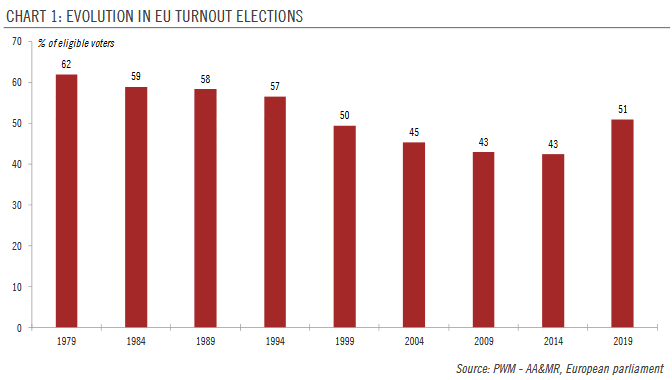|
Voter turnout for European parliament elections surged across the continent, exceeding 50% for the first time in a quarter century and breaking the downward trend of the last four decades. However, differences in turnout across the EU have been substantial and a more fragmented parliament has emerged. Voter turnout was up for the first time ever and at 51%, higher than in any election since 1994. The results delivered a parliament with a pro-European majority, broadly in line with opinion polls. The traditional centre-right European Popular Party (EPP) and the centre-left Socialist & Democrats (S&D) remained respectively the first and the second groups, but both suffered major losses. Indeed, the “grand coalition” of EPP and S&D has lost its traditional absolute majority for the first time since 1979. In contrast, the liberal ALDE camp, together with French President Macron’s Renaissance coalition, secured third place, while the Green party ranked fourth. This shows us that the pro-European camp has become much more fragmented than before. |
Evolution In EU Turnout Elections, 1979-2019 |
From a policy point of view, the strengthening of Europe’s Greens could bring climate change and EU social standards further into focus. But with the Greens’ critical view on free trade agreements, compromise on European trade policy could become increasingly challenging.
The key question of these elections was how strong Eurosceptic parties will be in the next European parliament elections. The parties around Italian PM Matteo Salvini’s new right-wing alliance (including the Rassemblement National in France and the AfD in Germany) rank fifth, with only one seat fewer than the Green Party. Thus, Salvini’s party could potentially come fourth, depending on future discussions with some parties. The European Conservatives and Reformists (ECR) lost seats and rank only sixth. The remaining parties from the current Europe of Freedom and Direct Democracy Group (EFDD) around the Italian anti-establishment Five star and the British Brexit Party secured 6% of the seats but require more parties to form their own group. Parties of the far-left United Left lost ground and are set to become the smallest group in the European Parliament. Thus, Eurosceptic/populist parties won more seats than in 2014, securing around 25% of the 751 seats, up from 20% five years ago. However, even if they share scepticism toward Europe, parties differ significantly in their focus, agenda and ideology.
Full story here Are you the author? Previous post See more for Next postTags: EU,Macroview,newsletter,Pictet





















